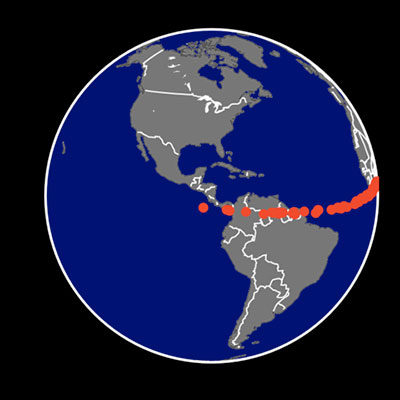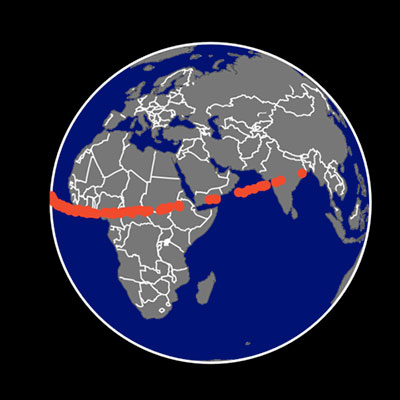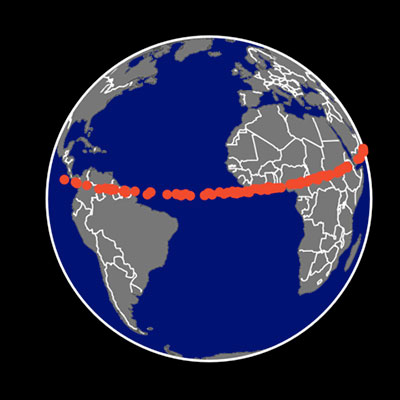|
Author
|
Topic: Asteroid 2024 YR4: Possible Earth impactor
|
Robert Pearlman
Editor Posts: 54344
From: Houston, TX
Registered: Nov 1999
|
 posted 02-09-2025 11:02 AM
posted 02-09-2025 11:02 AM
   
NASA release NASA Monitors Near-Earth Asteroid 2024 YR4While an extremely low possibility, observations and analysis of asteroid 2024 YR4 indicate that its impact probability with Earth is a 2.3% chance on Dec. 22, 2032. Ongoing observations from ground-based telescopes involved with the International Asteroid Warning Network will continue while the asteroid is still visible through April, after which it will be too faint to observe until around June 2028. NASA’s James Webb Space Telescope will also observe the asteroid in March 2025 to better assess the asteroid’s size. Currently the asteroid is estimated to be 130-300 feet across. As more observations of the asteroid’s orbit are obtained, its impact probability will become better known. It is possible that asteroid 2024 YR4 will be ruled out as an impact hazard, as has happened with many other objects that have previously appeared on NASA’s asteroid risk list, maintained by NASA’s Center for Near-Earth Object Studies. It is also possible its impact probability will continue to rise. The latest data will continue to be made available via NASA’s automated Sentry page. Asteroid 2024 YR4 was first reported on Dec. 27, 2024, to the Minor Planet Center– the international clearing house for small-body positional measurements – by the NASA-funded Asteroid Terrestrial-impact Last Alert System station in Chile. From former NASA astronaut Ed Lu (via X): B612 Foundation has taken the orbit and uncertainty of asteroid 2024YR4, sampled 10K trajectories from the current uncertainty, and propagated them forward. 2.3% of those hit the Earth on Dec. 22, 2032. Here is where they hit.  

|
Blackarrow
Member Posts: 3822
From: Belfast, United Kingdom
Registered: Feb 2002
|
 posted 02-09-2025 02:27 PM
posted 02-09-2025 02:27 PM
  
Imagine the political and military consequences if NASA mounts a DART-type mission to change the asteroid's trajectory eastward in order to save Bombay or Calcutta....and it hits Wuhan or Shanghai instead. (See "The Hammer of God" by Arthur C. Clarke for a fictionized account of the politics of "shifting the impact point.")Although the likelihood is that long-term observations will show no collision, I wouldn't agree that a 2.3% chance is "an extremely low possibility." |
Headshot
Member Posts: 1390
From: Vancouver, WA, USA
Registered: Feb 2012
|
 posted 02-09-2025 08:41 PM
posted 02-09-2025 08:41 PM
   
Agreed, from the numbers we have seen for other objects in the past, 2.3% seems disturbingly high. As pointed out, however, the more data points we get on this object, the more likely that number should get smaller. |
SpaceAholic
Member Posts: 5449
From: Sierra Vista, Arizona
Registered: Nov 1999
|
 posted 02-19-2025 06:40 AM
posted 02-19-2025 06:40 AM
   
Impact probability has ticked up sightly to 3.1% with latest trajectory data. |
Headshot
Member Posts: 1390
From: Vancouver, WA, USA
Registered: Feb 2012
|
 posted 02-19-2025 09:46 AM
posted 02-19-2025 09:46 AM
   
THAT is not good. |
Axman
Member Posts: 732
From: Derbyshire UK
Registered: Mar 2023
|
 posted 02-19-2025 10:11 AM
posted 02-19-2025 10:11 AM
   
Well, to be honest, it's not that bad either. There is still more than a 96% chance it will not impact Earth.And even if it did, the impact tractory is glancing not direct. A 130 foot wide stony meteorite at a glancing trajectory is hardly cause for panic. Even if it did enter the atmosphere (at that angle, there would be considerable atmospheric degradation) and impacted, the area of impact is still likely to be less than 0.0075% on densely inhabited areas. Pause for a moment, that is a possibility of 0.0075% of 3% that Calcutta or similar would be hit. By a 130 foot wide stony asteroid. It's not Chicxulub. It's not even the Fukushima tsunami. It's more like a fully fuel laden Boeing 747 hitting the centre of any major city you can name. More likely like a minor version of the Tunguska impact, with an air detonation that has theoretical atom bomb energies but practically zero effect on human survivability on the ground. Tragic, but not the end of the world. To put it another way, each and every day ~150,000 people die. Day in, day out. There are 8.2 billion people on the planet, which means that each day you wake up you have a probability of 0.001875% of dying that day. So basically, given the statistical probability of death, on the day the asteroid hits (or doesn't hit) the Earth, every single person alive that morning will have an equal chance of dying that day either by being stillborn, through senility, cancer, disease, being hit by a bus, falling off a ladder, slaughtered by a terrorist, or wiped out by space borne debris, or any number of improbable events, such as slipping on ice, or being eaten by wolves. |
SpaceAholic
Member Posts: 5449
From: Sierra Vista, Arizona
Registered: Nov 1999
|
 posted 02-19-2025 10:39 AM
posted 02-19-2025 10:39 AM
   
130 foot diameter is the low end of the calculated size (an iron meteorite of the same estimated diameter is attributed to the formation of the crater outside Winslow, Arizona, by the way). |
Blackarrow
Member Posts: 3822
From: Belfast, United Kingdom
Registered: Feb 2002
|
 posted 02-19-2025 11:13 AM
posted 02-19-2025 11:13 AM
  
quote:
Originally posted by Axman:
There is still more than a 96% chance it will not impact Earth... practically zero effect on human survivability on the ground.
I'm tempted to suggest that you wouldn't travel on an airliner which had only a 96% probability of arriving safely, but of course that would be social media logic. I realise that impact probability for the whole Earth is (currently) 3.1%, meaning an extremely small chance of an impact on any particular point (be it Lagos, or Calcutta, or Bombay, or the middle of the Atlantic).I assume your reference to "human survivability" is a reference to the survival of the human race, but for someone living beneath the potential impact track, human survivability will have a more parochial meaning. I can't help wondering how high the impact probability will have to be to persuade NASA and the other space agencies to attempt an intervention. What if they intervene but make matters worse? What if they don't intervene and a town none of us has ever heard of gets obliterated with the loss of 50,000 people? I assume they won't need to make any decisions until 2024 YR4 comes back in four years and more accurate predictions can be made. Has anyone suggested a name for this threat hanging over Earth? May I suggest "Damocles"? |
Axman
Member Posts: 732
From: Derbyshire UK
Registered: Mar 2023
|
 posted 02-19-2025 11:22 AM
posted 02-19-2025 11:22 AM
   
No. I meant individual survivability, not the survivability of the species. Sorry, I was adding to my original piece as you (and the previous poster) posted.And to answer your exact point, every time you step outside of your front door and travel by whatever means you choose, you have a real statistical probability of dying. You are going to die. It's unavoidable. The manner of your death cannot be accounted for. The asteroid doesn't increase your (or anybody else's) chance of death. Statistically, and in a proper sense, realistically, it is completely irrelevant. quote:
Originally posted by SpaceAholic:
...an iron meteorite of the same estimated diameter is attributed to the formation of the crater outside Winslow, Arizona, by the way.
It's not an iron asteroid. Its albedo is far too low. It's probably a carbonaceous asteroid. I was actually using Stony as an extreme example... |
Robert Pearlman
Editor Posts: 54344
From: Houston, TX
Registered: Nov 1999
|
 posted 02-19-2025 02:59 PM
posted 02-19-2025 02:59 PM
   
quote:
Originally posted by SpaceAholic:
Impact probability has ticked up sightly to 3.1%...
As of today, the probability of impact is down to 1.5 percent. |
Headshot
Member Posts: 1390
From: Vancouver, WA, USA
Registered: Feb 2012
|
 posted 02-19-2025 04:56 PM
posted 02-19-2025 04:56 PM
   
Using an online crater calculator, if the object is 100 meters in diameter, traveling at 25km/sec and hits the ocean surface at a 15 degree angle, we can expect a crater 2 km in diameter, an explosion around 51 megatons, and the release of 2.45 x 10(exp 17) joules of energy. I would imagine there would be tsunamis that would cause additional damage. Of course if it hits land, like say the Panama Canal, there might be unforseen economic consequences. |
Robert Pearlman
Editor Posts: 54344
From: Houston, TX
Registered: Nov 1999
|
 posted 02-23-2025 11:07 AM
posted 02-23-2025 11:07 AM
   
Additional observations of 2024 YR4 have now pretty much ruled out an impact. The latest probability is just 0.36 percent. |
Blackarrow
Member Posts: 3822
From: Belfast, United Kingdom
Registered: Feb 2002
|
 posted 02-26-2025 05:21 PM
posted 02-26-2025 05:21 PM
  
I doubt if that is newsworthy enough to make it into the popular press or social media. It's "the wrong kind of story." |
Robert Pearlman
Editor Posts: 54344
From: Houston, TX
Registered: Nov 1999
|
 posted 02-26-2025 05:26 PM
posted 02-26-2025 05:26 PM
   
To the contrary: CNN, AP, The New York Times, BBC Sky At Night, etc. |
Blackarrow
Member Posts: 3822
From: Belfast, United Kingdom
Registered: Feb 2002
|
 posted 02-27-2025 10:59 AM
posted 02-27-2025 10:59 AM
  
I stand corrected. The media can usually be relied on to trumpet the "We're all Doomed!" story, but not the "As you were, we'll be OK" story.But I still haven't seen the "good news story" on the news broadcasts on which I saw the "bad news story." |
Headshot
Member Posts: 1390
From: Vancouver, WA, USA
Registered: Feb 2012
|
 posted 04-01-2025 06:31 PM
posted 04-01-2025 06:31 PM
   
Just as sort of a follow-up. JWST has made observations of 2024YR and the results all but ruled out an impact with Earth. However, scientists have not yet ruled out an impact with the Moon.So far they have determined 2024YR is 60 meters in diameter plus or minus 7 meters (roughly the size of the Tungusta object) and its composition is estimated to be most like an S-type (stony) object. They will attempt more tracking and observing with JWST early next year. |














